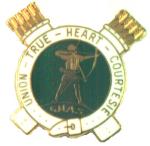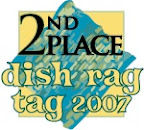This domino-esque tile game was the first one Cady Gray wanted to play. You play tiles in lines that have one of two attributes in common: either the same shape (of six possible), or the same color (of six possible). There's only about one page of instructions, and a helpful diagram of a sample game. We played without keeping track of points, but the kids caught on to the high-scoring moves (play tiles that count in more than one line, complete a set of six and earn a bonus) very quickly.
I love a lot of things about this game. There's no board, just a bag of tiles (substantial, brightly-colored, and well-made). Strategy is important but not complicated. Scoring is intuitive. In short, it's the perfect game for a range of ages. Both the five-year-old and the eight-year-old were competitive with me almost immediately. (I started off playing with Cady Gray while Archer was immersed in his favorite gift -- a handheld electronic chess game -- but after fifteen minutes he wandered over and started pestering me about playing the next game.) This one's going to have good staying power.
Another game whose easily-grasped rules makes it playable for a wide range of ages. In a Yahtzee-esque setup, the player rolls six dice, each with six simple symbols (angle, curve, line, squiggle, face, dot), and has three tries to match one of the figures on the "gallery" of cards that have been played. There are six colors of cards, each corresponding to a figure that takes one to six dice to complete. Your object is to match a figure from each color of card, thereby collecting that card and completing your set.
Like Quirkle, this is all about seeing spatial relationships and exercising foresight. Like Quirkle, there are no words or role-playing to get in the way of the pure challenge. And like Quirkle, the game is accessible from kindergarten-age through adults. It doesn't take very long, either. We were playing within five minutes of opening the box -- again, there's only one brief page of rules. Fun and addictive.
We knew Archer would be delighted by the chance to use ATM-style debit cards to keep track of his net worth in his updated Monopoly, but I've been hesitant to jump into Monopoly with him, quite frankly. It's long and relatively complicated, what with having to decide when to buy houses and mortgage properties. But I was surprised at how much he started enjoying himself right away. One of the only pieces of strategy I proffered was that he should buy up as many properties as possible at the beginning so they could start earning money for him; he immediately grasped it and was a super-mogul by the second time around the board. (He ended up schooling me in our first game, and not because I was hanging back, either.)
The amounts of money are ramped up in his edition -- the fact that you get $2 million for passing Go should give you an idea of the inflation rate. And the properties are famous landmarks all over the world. (I enjoyed collecting the Gateway Arch, Disney World, and the Grand Ole Opry.) But the only difference in game play is how you keep track of the money. Each player has a card, and there's a banking machine. All cards start off with $15 million. If you have to pay, put your card in the side with the minus sign, and enter the amount in either K or M (thousands or millions). If you're being paid, put your card in the plus sign side and do the same thing. And if you're paying another player, put both cards in on the appropriate side, type in the amount, and it transfers.
The real drawback here is that you have to put your card in the machine to see how much money you have. I found myself asking Archer frequently (he was operating the machine, naturally, and usually he remembered from the last time he'd inserted my card). It might be helpful for everyone to keep their latest balance jotted down on scratch paper as they play.
But I found this a faithful rendition of a classic, with a numerical/electronic component that's tailor-made to delight my number/calculator/ATM/money-obsessed autist. His sister came in near the end-game and asked (characteristically) whether she could be the banker "but not play" next time.
I'm really happy about the way this one worked out. Stuck about a week before Christmas with nothing for pretend-play to put under the tree, I steered Noel toward Trios (which I'd wanted to get for CG's birthday, but didn't manage to procure). He got this castle building set, and spent a couple of happy hours this afternoon putting it together with her. (She enthusiastically adopted his motto for how to tell if the pieces had locked together firmly: "A satisfying snap!"). I was amazed at how big it turned out to be. There are quite a few figures and accessories, and as soon as it was together (CG was able to handle much of the construction solo, with Dad assisting when modules had to be combined), she started having the dragon-catapult attack and putting the little minifig-like knights into single combat or having them man the cannon and crossbow.
There are several other suggestions for ways to combine the building pieces to make different varieties of castles and towers. I was hoping that a Trios set would combine CG's pride in creative construction with her love of role-playing. From her happy embrace of the set this afternoon, I think I was right.





No comments:
Post a Comment